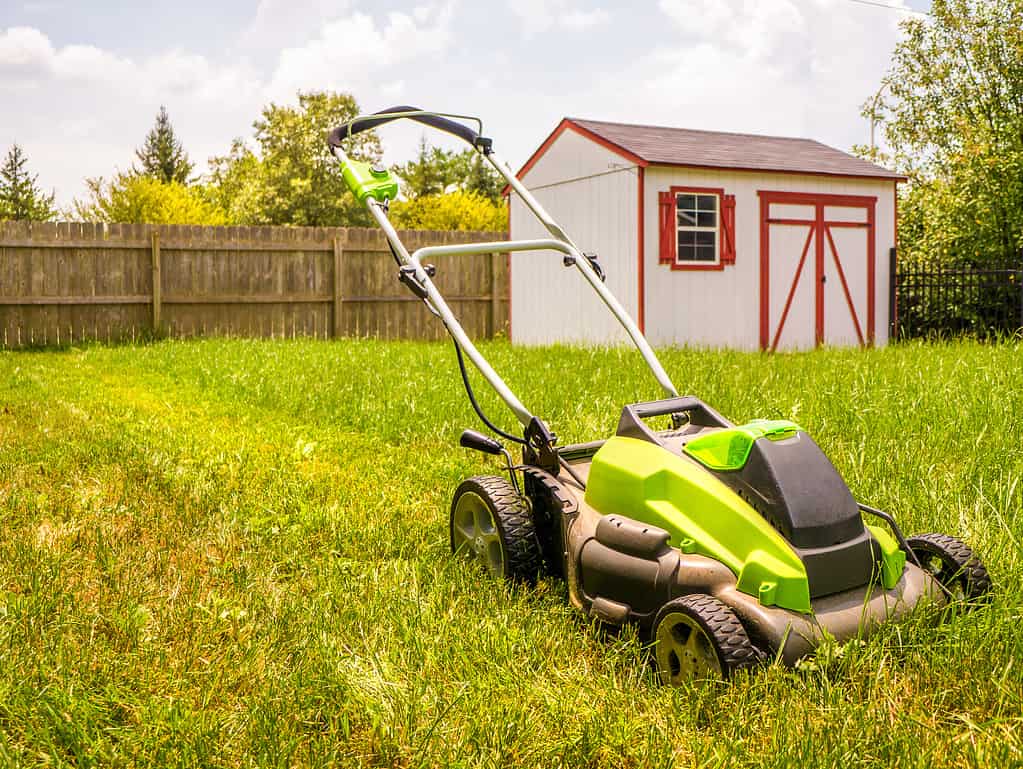
Store your lawnmower in a storage shed and off the ground to protect it from pests.
©leightrail/iStock via Getty Images
Lawns evoke a sense of pride in homeowners, providing a lush landscape that frames a property. As such, they require feeding, weeding, and regular clippings to look their best. There’s no doubt there are questions about what to do in the winter months when things go dormant and temperatures drop. Fortunately, grass is resilient and with a few good tips on how to prepare for winter temperatures, a lawn will do well through the cold weather. In this article, we will review the 7 reasons you should never leave your grass too long before winter.
Keeping grass blades around 1½ to 2 inches long, depending on location and type of grass, provides a more resilient lawn with deeper roots and stronger plants. As a result, this enables a faster rebound in the spring. It’s time to stop cutting the lawn when its growth slows which may start in November or December, based on your area, or when the frosts begin. In fact, temperatures below 50 degrees Fahrenheit will cause a lawn to go dormant.
With each mowing try not to remove more than a third of the blade length and avoid cutting when wet. Mowing during damp weather could contribute to soil damage from water pooling on the lawn which may lead to pest infestations and lawn heaving. It is best to set the mower to a high-cut setting to allow for photosynthesizing during dark winter months.
7 Reasons You Should Never Leave Your Grass Too Long Before Winter
- Helps to eliminate fungal and lawn diseases
- Attracts less debris
- Helps to eliminate pests
- Enables a resilient, stronger lawn with deeper roots for spring
- Protects lawns in areas with snow
- Easier to fertilize
- Easier to seed
Helps to Eliminate Fungal and Lawn Diseases
Longer grass blade length is susceptible to fungal disease which will kill a lawn. In addition, winter rains mat long grass and allow the fungus to grow which will harm it. Cutting grass shorter enables it to stand up to winter storms. Aerating the soil improves water absorption and boosts lawn health. Some common lawn diseases include:
- Red thread: browning patches of dead grass with red threads on the stalks
- Dry patches: fungus buildup causing dry patches and the inability to absorb water
- Brown or yellow patches: fungus buildup
Attracts Less Debris
As fall approaches a normal garden activity includes rake falling leaves. Not only does this keep the entire garden clean, but raking leaves prevents the mower from running over them as well as twigs or other debris which dull the mower blades and in turn rip grass blades. Debris creates an environment for fungus and disease to take hold, for that reason it is best to rake and/or use a blower to keep the lawn clear over the winter. In fact, decaying matter is not good for dormant grass. A cleared lawn allows for aeration which promotes growth, improves drainage, and reduces the possibility of compaction.
Keeping a lawn at a shorter height during the winter months also attracts less debris in the future by allowing winter winds to blow leaves across the surface. Raking the lawn at the end of winter breaks up clumps and mats that may have accumulated which improves airflow. Storing garden implements such as hoses, sprinklers, and yard decorations will prevent the lawn from becoming matted and attracting pests that could kill or damage it.
Helps to Eliminate Pests
The added moisture from snow and rain in the winter months creates a perfect environment for pests to damage or kill lawns. These include slugs, roaches, voles, caterpillars, snails, ticks, and fleas. Tall grasses serve as a shield from the elements and invite pests like mice to hide in them away from hungry predators. Snakes also love tall grass which might provide a food source for them if mice are present. Keeping a shorter cut will eliminate these pests from inhabiting gardens.
Enables a Resilient, Stronger Lawn with Deeper Roots for Spring
Cutting a lawn to a winter height allows for it to be healthier. Specifically, it allows for sunlight to warm the soil enabling earlier spring growth.
Protects Lawns in Areas with Snow
Snow mold, also known as Fusarium patch, is mostly seen in northern climates with cold and damp conditions which are ideal for it to take hold. This mold is first noted by brown patches followed by fluffy white mold which folds longer grass blades over the crown leading to rot and eventually killing the lawn. Accordingly, a shorter grass cut will prevent this disease. In addition, it is important to avoid shoveling snow from driveways, sidewalks, or walkways onto the lawn which inhibits new growth and damages the lawn with its weight. Also, avoid walking on frozen grass so as not to break the blades and damage the lawn.
After the winter snow has melted, lightly rake lawns in early spring to perk up the grass and clear away dead leaves or other debris that may have accumulated over the winter months. Care should be taken when raking so as not to pull up emerging new shoots. In doing this, it will help to break up matting and improve airflow.
Easier to Fertilize
Fertilizer applied in the late fall months allows the grass roots to absorb nutrients which they will store over the winter months and slowly use as food. Using a spreader is a quick way to distribute fertilizer over a freshly cut winter lawn allowing it to reach down into the roots. Aerate the soil to allow for deeper penetration.
Easier to Seed
Aerating and seeding will help the lawn bounce back quickly from winter weather. Spreading grass seeds over existing winter cuts will introduce fresh growth for the next season giving it time to take root and absorb nutrients. This is known as dormant seeding which allows the seed more time to develop and will germinate when spring begins.
Different Lawns with Different Needs

Bermuda grass is heat, salt, and humidity tolerant making it a popular choice for gardens.
©aimful/Shutterstock.com
Different types of grass require different care, some of the more popular ones include:
- St. Augustine Grass
- Bermuda Grass
- Buffalo Grass
- Zoysia Grass
St. Augustine Grass
A good winter height for this grass is around 3 inches which will go dormant about early to mid-November. When spring begins, a slightly lower height will help it revive from winter dormancy.
Bermuda Grass
The ideal winter height for this low-maintenance turf grass is around 2 inches, it and will enter dormancy around September. Cutting it to around 1½ to 2½ inches in the spring will encourage new growth.
Buffalo Grass
This prairie grass survives moderate winters with an ideal height of 5 inches in the dormant winter months. In spring and summer, 4-6 inches is the ideal height.
Zoysia Grass
As this tolerant grass goes dormant in the winter it should be kept at 3 inches. The ideal spring and summer height is 2½ to 3½ inches.
In Conclusion
Lawn maintenance is an ongoing job. But understanding some basic rules will result in a lush and beautiful lawn. Winterizing the lawn will vary by location. Cutting the grass in winter allows it to remain healthy during cold weather. However, please don’t cut it too short as it will need a bit of protection during harsh conditions. A shorter grass length resists molds, fungus, and lawn diseases as well as a variety of pests that were reviewed in the 7 reasons you should never leave your grass too long before winter.
| Reasons to cut grass before winter | Examples |
|---|---|
| Helps to eliminate fungal and lawn diseases | Fungal diseases will kill lawn |
| Attracts less debris | Debris can harm mowers and damage the lawn |
| Helps to eliminate pests | Long grass hides pests in winter |
| Enables a resilient, stronger lawn with deeper roots for spring | Healthy winter lawns green up faster in spring |
| Protects lawns in areas with snow | Snow can harbor mold |
| Easier to fertilize | Fertilizer gives grass a head start |
| Easier to seed | Seeding allows roots to develop over winter |
The photo featured at the top of this post is © MariuszBlach/iStock via Getty Images
Thank you for reading! Have some feedback for us? Contact the AZ Animals editorial team.







